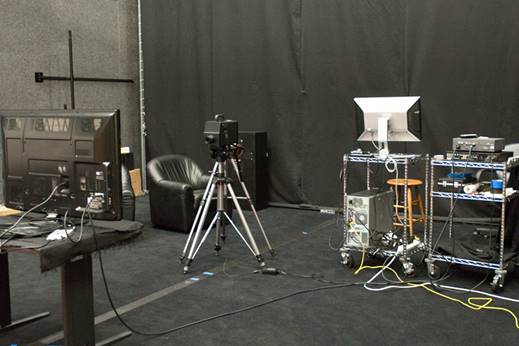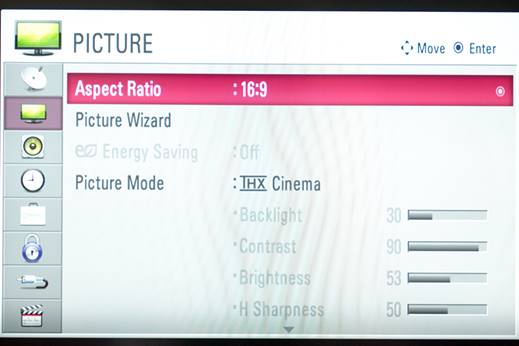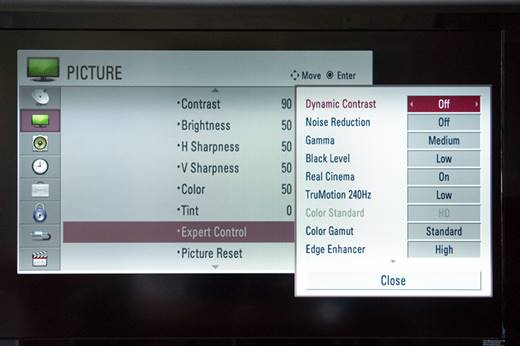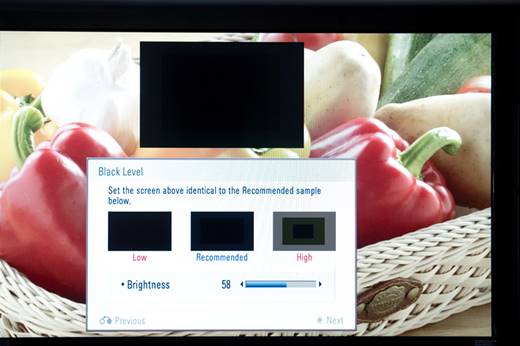THX Certified HDTVs - Useful or Just Marketing?
by Loyd Case on March 6, 2010 12:00 AM EST- Posted in
- Smartphones
- Mobile
In the Lab
All this talk about setting standards and assisting companies develop products that meet those stringent standards is well and good, but what’s involved in the testing process?
THX has both audio and video labs at their San Rafael, California facility. The audio labs include an anechoic chamber, studio space and test equipment. The HDTV test lab consists of two separate labs. One large space can be completely darkened, and is used to test panel uniformity, color tracking, color temperature and other parameters. The main instrument is a Konica-Minolta CS-2000 spectroradiometer, used to measure contrast ratios, color temperature and related specs. Also on tap is a high end digital camera back used to measure panel uniformity.

A panel manufacturer begins with very early samples, often lacking amenities like bezels, in order to start dialing in the electronics. At the beginning, the result may be pretty poor.
![]() Image: color tracking -- bad
Image: color tracking -- bad
Over time, the panel electronics are tweaked, software updates written and all the various pieces are tuned to bring the final result close to that magical linearity.
![]()
The second lab is the subjective test lab. Tests that require visual inspection, like anti-aliasing performance, happen in this lab. While some actual content from film and video sources is viewed as a sort of final sanity check, most of what occurs is visual inspection of test patterns. Some of the testing is more aggressive than publicly available tests. For example, it’s possible that an HDTV panel might pass the publicly available HQV benchmark for anti-aliasing, but fail on the THX test.
The bottom line: there’s a ton of testing and tweaking that goes on before an HDTV receives THX video certification. How does this play in the real world? Let’s take a look at a case study.
Case Study: The LG 55LH90 LCD HDTV
LG makes a number of THX certified HDTV. The current high end of their LCD line is the LG 55LH90. This is a zone-backlit LCD using LED backlighting. In addition to THX certification, the unit offers two “ISF” settings. (ISF is the Imaging Science Foundation, which trains and certifies custom installers for home theater video calibration work.)
LG loaned me a 55LH90 to try out in my living space, so what I’ll be discussing isn’t some unit in an ideal lab, but one in my viewing room. My family room has a large glass patio door on one side, and overhead lighting which isn’t dimmable. It’s a 15’ x 15’ area, with the main seating about 7 feet back from the HDTV.
The LG unit offers a THX setting, which is set to about 130 cd/m2, with zone backlighting enabled. It’s worth discussing the differences between the THX settings and the ISF menu entries.
The THX setting is tuned for film material, though certainly works well on standard HDTV content as well. It’s a “what you see is what you get” setting. In fact, many of the normally tweakable settings are grayed out. You can think of the THX setting as a sort of pre-calibrated setting suitable for relatively light controlled viewing environments.

Note how much the backlighting is dialed down – it’s set to 30%. The THX setting also disables high refresh rate and dynamic contrast ratio settings.
The ISF settings, on the other hand, are there specifically for tweaking by professional calibrators, though users are certainly free to change them as well; these are not hidden under some special factory code.

Interestingly, the 55LH90 also has a simple, but useful, calibration routine built into the menu system. If you don’t like any of the out-of-the-box settings, but don’t want to pay for custom calibration, then you can use the built in tools to perform a good, first level calibration. As with similar tools on the PC, you’re walked through a series of screens which allow you to tweak black levels, brightness and color best suited to your viewing tastes and environment.

The THX mode looks stunning to my eyes -- particularly with movie and episodic TV content. Blu-ray movies, in particular, offer up impressive black levels and terrific detail. I’ve seen a lot of LCD TVs, and have always leaned towards plasmas. No LCD TV has ever really satisfied my viewing tastes – until now. I can safely say that this LG unit is the best LCT HDTV I’ve seen to date. Even viewing angles seem better than past LCDs I’ve viewed – but bear in mind my 15x15 space means no one really sits at steeper off-axis angles.
Since most of our HDTV viewing is in the evening, light control really isn’t an issue. Even during sunny daylight, though, the brightness seems adequate in THX mode. While we do have a large sliding glass door, we never get direct sunlight into the room.
I’ve tweaked settings for other types of material. I’ve been watching the Winter Olympics in high def recently. While THX mode is sufficient, it’s not really enough, and tweaking the settings – including enabling the higher frame rate – makes viewing that type of content more enjoyable. Interestingly, the “Sports” preset was too bright for Olympics, though it did look fine when watching the Super Bowl.
Given my experience, the LG unit gets a definite thumbs up. But my experience with THX mode isn’t mirrored by others. CNET’s test lab found THX mode to be quite blue . That wasn’t reflected in the THX mode I saw, which had no visible blue cast, as an 8200K average color temperature would indicate. That points to potential product quality inconsistencies or perhaps a firmware update on my version.
There is, of course, a price premium, though not as much as you’d suspect. Recent price checks show the LG 55LH90 priced at a around $2,000. That’s not out of line for 55-inch premium HDTVs. Some Samsung and Sony units can cost quite a bit more. So for your $2K, get an excellent LCD HDTV with zone LED backlighting (not edge backlit) and a THX preset that serves quite well for movie watching. On top of that, you can tweak almost every setting to your heart’s content.










30 Comments
View All Comments
Ram21 - Monday, March 8, 2010 - link
I enjoyed this piece, excellent description of THX certifications.cheinonen - Monday, March 8, 2010 - link
As much as I am loathe to defend Lexicon and the whole Oppo debate, using this as an example for THX being good or bad, at least for the reasons people have been citing, is incorrect because:- Oppo didn't submit the player for THX certification, for whatever reason (cost, not caring about it, I don't know) so the Oppo can't be THX certified if you buy it from Oppo
- Lexicon did submit it for THX certification, and since the Oppo is very well designed and can pass everything that THX needs for video certification, it can be THX certified when sold by Lexicon, but not by Oppo, since Lexicon paid the fee for testing and the label
- It's not THX certified for the audio section, as people have found that the 80Hz crossover doesn't have the correct slopes or crossover point to fit the THX standard.
- THX has nothing to do with Lexicon using the Oppo for their player, or what it sells for, and to say that THX shouldn't certify products that conforms to their specs because someone else designed part of it (which would eliminate most gear out there), or the price is too high, would remove most THX certifications out there.
I'd also cross over those Studio 20's at around 60 Hz or so myself, since the driver is going to have to work much harder to go full range, and the receiver will be working harder than if it was passing that material off to a subwoofer. Also, you'll be missing out on most, if not all, information below 45Hz or so unless you have double bass turned on in your receiver (not the best idea).
I have fronts that can run down to around 24Hz for their -3 db point and I still will cross them over at 40 Hz or so, to make it easier for the amp to drive them, and I have the option to run them full range (no sub) if I am passing in analog from a turntable or a CD player, which perhaps is how you'd want to run the Studio 20's.
queequeg99 - Tuesday, March 9, 2010 - link
Is there any way to determine whether a THX product is certified for audio only or video only before a company is called out like Lexicon was? I just see the THX logo on the device itself and marketroid literature touting "THX certification." I don't recall seeing any marketing or sales information on the Lexicon or other products that makes the distinction that THX is now making.Given the strong audio features of this device, not being very clear about what is actually being certified is seriously misleading.
cjb110 - Monday, March 8, 2010 - link
I remember choosing my first home cinema receiver when DVD's were first introduced. At the time there was a lot of forum chatter about THX certification, Yamaha's stance at the time was that they did as stringent as tests as THX, and therefore didn't see the need in upping the cost just for the badge.Ok that's could just be PR, but the 2nd comment from the same source also stated that THX is meant for home movies, not general purpose (ie stereo music playback).
And they we're right, at the time Yamaha's were also considered the best for 2ch music AND movie viewing...the THX'd Denons were good for movie, and so so for music.
Point is that THX emphasises the movie experiance, sometimes to the degredation of other uses of the equipment.
knutjb - Sunday, March 7, 2010 - link
THX is a marketing label implying a certain level of quality. It really just means a given product meats a predefined set of measurements. Measurements don't necessarily mean it sounds or looks good.If you're looking at a monitor like you would watch a movie, in a darkened room without people interrupting every minute, you will likely find what works for you, label or not.
Same goes for sound, I didn't like the THX settings. They sounded flat and thin to me. I experimented with different settings in the store to see how much latitude I would have at home. I ended up with different equipment than I thought I was going to buy. I have small speakers running on full size and I went through a number of subwoofer crossover settings to find the best blend for my room. If the sub is set too high it won't disappear and for me 80hz is like a flashing light. Knocked it down to 60hz and it all seams to blend much better.
Like the author, experiment with your settings for both monitor and sound and you can get very good results without spending silly money.
jabber - Sunday, March 7, 2010 - link
....after the Lexicon/Oppo scandal a few weeks ago.Badge for sale!
cosmotic - Sunday, March 7, 2010 - link
Is in no way consistent. Temperature, quantity, and taste all differ way too much.shotage - Saturday, March 6, 2010 - link
Thanks Loyd, this was a good read.I look forward to a few more articles touching on similar topics i.e. sound!
Keep up the good work!
idealego - Saturday, March 6, 2010 - link
"When THX certifies a piece of hardware – say, an A/V receiver – it works closely with the company building the receiver"THX might want people to think this, but there is a lot of evidence to suggest that this isn't true. For example, many products are THX certified by a company that simply rebadges the product, even though the original manufacturer was never involved in THX certification and continues to sell the product under their brand without THX certification.
queequeg99 - Saturday, March 6, 2010 - link
After reading about all of the foolishness surrounding the THX certification of the new Lexicon BD player, I would be hesitant to pay any material premium for THX certified equipment.